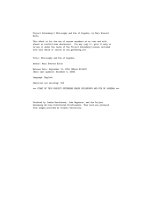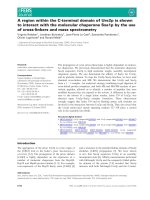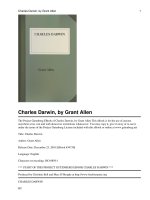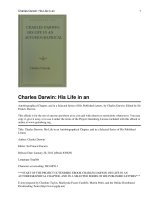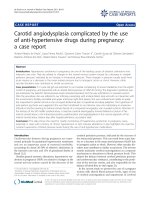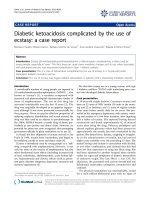Production of Denim Fabric By The Use Of Slasher Dyeing
Bạn đang xem bản rút gọn của tài liệu. Xem và tải ngay bản đầy đủ của tài liệu tại đây (1.8 MB, 90 trang )
“PRODUCTION OF DENIM FABRIC BY THE USE OF
SLASHER DYEING”
DEPARTMENT OF TEXTILE ENGINEERING
Project Report On
“PRODUCTION OF DENIM FABRIC BY THE USE OF SLASHER DYEING”
Introduction
Introduction
Denim is the oldest, most widely used, most fashionable and most versatile fabric of the world. At
present denim is mainly used for producing garments particularly trousers for the young people.
The gross production of denim fabric is approximately 3,000 million metres per year.
Denims are produced from 4 oz. to 16 oz./ sq. yds in weight. Technically Denim is defined as
a 3/1 warp faced twill but also produced from weaves like: Left hand twill, right hand twill, broken
twill, cross hatches, cords, dobby's, structures, etc .
Denims are made from yarn dyed warp and undyed weft. Traditionally, denim was dyed
with various shades of indigo, yarn-dyed, different costs, and over-dyed with various types finishes
at fabric as well as garments state. Denims are manufactured different types of after treatments or
washes like stone wash, bleach wash, hand wash, acid wash, over dyed, printed denims and even
embossed.
Denim fabrics are used as jeans trousers both for men and ladies. It is extensively used in the
world as casual garments, Shirts, jackets, children wears are also made of denim fabrics. Its
versatility, finds applications in furniture upholstery, bed covers, curtains, etc. Denim now-a-days
is a very demandable product. To make a denim fabric the required yarn for the definite
construction should be dyed then make a weavers beam to go to weaving to make fabric.
TYPE OF FABRIC :
TYPE OF FABRIC :
Normal Fabric
Ring Fabric
Half Cross Fabric
Cross Latch Fabric
FABRIC IDENTIFICATION :
Normal Fabric = 6 OE * 6 OE / 66 * 35
Ring Fabric = 6, 9, 12 * 7 OE / 66 * 35
Half Cross Fabric = 6 slub * 7 OE / 66 * 35
Cross Latch Fabric = 10 slub * 10 slub / 66 * 35
TYPE:
'Some typical denim fabric
construction:
Description Wt
oz/yd
2
Construction: Finished
Fabric
Desig
n
100%Cotton indigo Half Cross
Denim
6 89X55/20RsX16R+16R
s
2/1
RHT
1 00%Cotton indigo Ring OE 8 77X49/13RX12R 2/1
RHT
100%Cotton indigo Vertical
Slub
7.25 68X49/1 ORsX20K i2/IRH
T
100%Cotton light Indigo Slub
Lucky
6.50 79X49/1 6RX14Rs 2/1
RHT
98.5%cotton 1 .5%lycra park
indigo stretch slub
11.50 65X46/7.5RsX8+70D 3/1
RHT
100% Cotton indigo normal 12 10 OE+10 OE*12
OE/69*44
2/1
RHT
100% Cotton indigo 12.10 9 Rs+ 9 R * 7Rs + 7R/
72 *48
3/1
RHT
100% Cotton indigo 11.65 8 Rs + 9R* 8Rs (MC) /
68 *50
3/1
RHT
100% Cotton indigo 9.8 9 OES+ 9 OE* 10 OE /
75 * 43
2/1
RHT
Most of the denims are produced with 100% cotton and cotton-based blends with Lycra®,
Polyester, Tencel®, Bamboo, Jute, Nylon, and Linen etc. An ideal cotton mix for denim should
have the following quality parameters.
2.5% span length > 25mm
Strength (g/tex) >18
Micronaire > 4.5 to 5.0
Maturity Coefficient >0.75
Uniformity Ratio> 49%
Trash> 4.9%
In Bangladeshi mills, in most cases substantial quantity of waste yarns are used. This is
mainly done to reduce the cost of production. A well established mix for denim yarns are as
follows;
i. 80% waste, which consists of
(i) Dropping-1,
(ii) Dropping-2,
(iii) Flat strip,
(iv) Comber noil.
ii. 20% Fresh Cotton
FIBRE
YARN
(i) Rotor yams are the best and most widely used yarns in Denim production.
Because of their very high speed rotor yams are much cheaper than ring spun yams.
Off course rotor can only produce yarns of up to 30Ne. Though cheap rotor yarns are
associated with greater imperfections than corresponding ring yarns therefore knit
goods are produced from ring yarns.
(ii) Count range from 6 to 16 Ne but most widely used range is 7 to 12 Ne.
For slub yarn the range is 9 to 20 Ne.
(iii) Quality- Counf CV-<1.2, Single yarn strength> 12.8 gm/tex, Elongation>
6.0,U% <9.5.
(iv)As huge amount of slub yarns are used today the idea of too much strict
U% is not considered.
The diameter of slub varies froml.SD to 2.2D (Where D is the normal dia of yarn). The
periodicity of slub also varies widely. Test results show mat the distances between
two adjacent slubs varies within certain range. Some of the usual range distances
between two adjacent slubs are from 6cm to 10cm, 7 cm to 20 cm, 30cm to 60cm.
Some more information on yarns are given in weaving section later
Fig: Unwinding of creel
Fig: Warpers beam
The thread from the packages in the creel is wound on to a beam to make warp beam.
PARTICULARS OF A DIRECT WARPING MACHINE
Setup parameter
>• *
Range Set value
Warping Length 1
-99,999m
Based on
quantity
yarn count, warping beam,
capacity
Cone/Cheese no. in the creel !
325-410
Based on customer fabric construction
Machine speed l-
800m/min
650
m/min;
Based on yarn count and
quality
Length correction % 1 156%
Stop motion
I
m-
second
Don't need
Supply Pressure 1-8 bar 5 bar
Beaming Pressure 1-160 40psi
Press Pressure 1-160 30psi
Carrier Pressure 1-160 50/55 psi
Hydraulic Pressure 0-40 16Psi
The following twoDyeing methods are most popular processes for manufacture of
denim
SLASHER DYEING:
Slasher dyeing dyes the yarns in the warp beam form. It is a continuous
process which combines dyeing & sizing in a single operation. Dyeing is done by
continuously passing warp yarns through several (at least 5) troughs of indigo dye
liquor. The dyed yarns are then sized & wound onto a warp beam to be ready for use in
the weaving process. Slasher dyeing is usually of inferior quality as compared to rope
dyeing shade evenness or side-to-side shade variations. With the slasher dyeing, the
penetration of dyestuff is poorer, and it is easily reveals an uneven pick-up along its
width with the distortion of the pad-roll.
Fig: Diagram of Slasher Dyeing
FLOWCHART OF DYEING & SIZING:
Warper’s Beam
↓
Pretreatment (Scouring) bath
↓
Dryer- wash bath (1, 2, 3)
↓
Color box - 1
↓
Dryer - 1
↓
Color box- 2
↓
Dryer - 2 (Air oxidation is done here)
↓
Color box - 3
↓
Steam box
↓
Color box - 4
↓
Yarn pass between a set of guide roller for oxidation
↓
Color box - 5
↓
Oxidation
↓
Color box - 6
↓
Guide Roller
↓
Color box - 7
↓
Oxidation
↓
Color box - 8
↓
Oxidation
↓
Wash box (1, 2, 3)
↓
Dryer
↓
Sizing box
↓
Dryer
↓
Accumulator
↓
Leasing
↓
Winding
↓
Weaver’s beam
•
Type- Sliding creel
•
Arrangement- Two creels are placed parallel to each others.
•
Creel capacity-16 warp beams can be placed in each creel.
•
Electronic motor is available to slide the creel as well as mount the beams.
Beam creel section:
Fig: Beam creel
Capacity of cooking tank: 1000
Ltr
Cooking Temperature: 85º
Cooking time: 25-50 mins
Pick up: 5-10%
Cylinder temperature: 110-130ºc
Squeezing Pressure: By top
roller
Delivery squeeze pressure:
Lowest: 12-17 kN
Highest: 15-20 KN
Stretch: 0.7-1%
Refractro reading: 7-11%
Viscosity: 12-30 sec
Sizing Temperature: 85-90ºc
Sizing BATH:
No of dry cylinders used in this bath = 12
Sizing parameter:
Fig: Sizing Tank
Scouring:
Natural fibers contain oil, fats & waxes together with other impurities. During manufacturing oil & adventitious dirt
are collected. And these are affected the absorbency of the cloths & leads to uneven dyeing. Oil, fats & waxes are all insoluble
in water; they dissolve in organic solvents such as Chloroform, Ether and Petrol etc. Scouring is the process to remove all
these impurities to make a more absorbent, hydrophilic & clean fabric.
OBJECT:
1. 01. To remove natural & added impurities like oil, wax, gum, fatty material as completely as possible.
2. 02. To get a clean & even fabric surface for the next process.
3. 03. To increase the absorbency of the fabric, i.e. to make the fabric hydrophilic, so that it can absorb dye molecule,
water & other processing easily.
Scouring Recipe:
NaoH= 36-145 gpl or g/l
Wetting agent (Lionil EH) = 0.5g/l
Temperature=85ºc
Water = 1400 liter
Squeezing roller pressure = 4-5 bar
FUNCTION OF THE CHEMICALS USED IN SCOURING:
1. Alkali: It converts the oil into water soluble fatty acid & soap.
02. Wetting agent: A soluble or dispersible material that reduces the surface tension between the material & liquid. Detergency
effect helps to clean the material.
03. Sequestering agent: It reacts with metallic ions & thus makes the metallic compounds to become a part of complex anion.
DYEING:
Dyeing is consists of 2 dyes. The indigo blue & Sulphur black is used in the dyeing process of denim. Sometimes brown
color is used instead of indigo blue in the factory according to the requirement of buyer.
DYEING RECIPE:
For leuco preparation here is a ratio which is followed:
Indigo : 100 g/l
Caustic Soda : 73 g/l
Reducing agent : 93 g/l
Dispersing agent : 0.5 g/l
Sequestering agent : 0.5 g/l
Wetting agent : 0.3 g/l
For black preparation the following ratio is followed:
Black : 35 g/l
Caustic Soda : 15 g/l
Antioxidant : 15 g/l
Sequestering agent : 0.5 g/l
Wetting agent : 0.5 g/l
Dyeing Process:
Dyeing process that is maintained as follows:
Pure Indigo- Continuous Indigo Dyeing
Bottoming- Sulphur(Bottom) & Indigo(Topping)
Topping- Indigo(Bottoming) & Sulphur (Topping)
Black Denim-Continuous Sulphur Black Dyeing
Color Denim.
LIST OF SOME CHEMICALS ARE USED & AND THEIR FUNCTION:
Pimazol ws:
Use as pre-wetting agent to reduce the surface tension of the liquor and allow to penetrated in to the fibers.
Sodium Hydrosulphite / Hydrose:
It is a reducing agent. It converts the insoluble vat dye to soluble leuco form & also to remove dissolved oxygen
from water.
Na2S2O4 + H2O + [O] = 2NaHSO3
Specification: ISO 9001, ISO 14001, OHSAS 18001
Purity = 90% min
Country = China
Caustic Soda:
It is scouring agent and removes impurities from the fiber. It is used here as pH controlling agent. NaHSO3 is
produced in the vatting bath which has the tendency to destroy leuco compound. To remove NaHSO3, alkali is used.
NaHSO3 + NaOH = Na2O3 + H2O
Specification:
“Caustic Soda Flakes’’
NaOH =96%min
Country = China
Ladiquest: It is a sequestering agent and use to remove the hardness of water.
Specification:
Name = 1097 – U liq
Country = Thailand
Setamol-Ws:
It is a dispersing agent. It is used to disperse the dye molecule properly in the dye solution.
Specification:
Manufacturer = BASF
Country = India
Persoftal BD (Paste):
It is a softener, used to soften the fabric in the finishing process.
Antioxidant:
It is used to protect oxidation of dye molecule in dye bath. It is used as reducing agent while Sulphur black is
used. It is also known as monohydrate glucose.
Acetic Acid:
It is used to reduce the percentage of pH in dye bath.
Specification:
Name = Acetic acid Glasiroyal
Composition:
Acery = 99%
Water = 0.7-1 %
Acetic anhydride = 0.3%
SIZING
Sizing Mills coat yarn with polyvinyl alcohol and starch for strength, and paraffin to make it easier to weave into
cloth and handle in sewing. It is a film- forming polymeric materials, which is applied to a warp sheet for the purpose of
protecting it during the weaving process.
Objects:-
•
To increase the strength of yarn Up to 20% after the size application.
•
To improve the hairiness, thick and thin places, Neps knots in the warp yarn.
•
To protect the warp yarn from breakage during weaving process. Which is subjected to abrasion width varies loom parts
such as reed heald shaft Shuttle, Splitting rod.
Sizing composition depends on the following factors:
•
Types of fibers
•
Types of yarn
•
Yarn quality
•
Quality particulars of fabric to be woven
•
M/c condition & ambient condition of the loom shade
•
Cost of various ingredients
